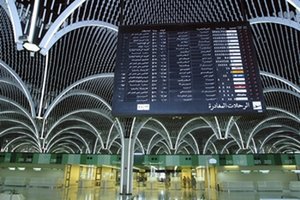Airport terminal
|
|
An airport terminal is a building at an airport where passengers transfer from ground transportation to the facilities that allow them to board airplanes.
Passengers taking a flight will typically take an automobile, taxi, bus, or train to the airport and then enter the terminal. Within the terminal, passengers purchase tickets, transfer their luggage, and go through security. The buildings that provide access to the airplanes (via gates) are typically called concourses. However, the terms "terminal" and "concourse" are sometimes used interchangeably, depending on the configuration of the airport.
Smaller airports have one terminal while larger airports have several terminals and/or concourses. At small airports, the single terminal building typically serves all of the functions of a terminal and a concourse.
Some larger airports have one terminal that is connected to multiple concourses via walkways, skybridges, or underground tunnels (such as Denver International Airport). Some larger airports have more than one terminal, each with one or more concourses (such as New York's La Guardia Airport. Still other larger airports have multiple terminals each of which incorporate the functions of a concourse (such as Dallas/Fort Worth International Airport).
Most airport terminals are built in a plain style. However, some, such as Baghdad International Airport, are monumental in stature, while others are considered architectual masterpieces, such as Terminal 1 at Charles de Gaulle airport near Paris. A few are designed to reflect the culture of a particular area, an example being the terminal at Albuquerque International Sunport in New Mexico, which is designed in the Pueblo revival style popularized by architect John Gaw Meem.
| Contents |
Airport terminal designs
Early airport terminals opened directly onto the tarmac: passengers would walk or take a bus to their aircraft. This design is still common among smaller airports, and even many larger airports have "bus gates" to accommodate aircraft beyond the main terminal.
A pier design uses a long, narrow building with aircraft parked on both sides. One end connects to a ticketing and baggage claim area. Piers offer high aircraft capacity and simplicity of design, but often result in a long distance from the check-in counter to the gate (up to half a mile in the case of Kansai International Airport). Most large international airports have piers, including Chicago's O'Hare International Airport, Frankfurt International Airport, London Heathrow Airport, and Miami International Airport.
A satellite terminal is a building detached from other airport buildings, so that aircraft can park around its entire circumference. Satellite terminals offer high aircraft capacity for their square footage, but require comparatively sophisticated transit systems to move passengers in and out (often underground or by people mover). Paris's Charles de Gaulle International Airport (Terminal 1) and London Gatwick Airport (South Terminal) both have circular satellite terminals: Orlando International Airport and Pittsburgh International Airport have multipier satellite terminals, and Denver International Airport has linear satellite terminals.
Some airports use a semicircular terminal, with aircraft parked on one side and cars on the other. This design results in long walks for connecting passengers, but greatly reduces travel times between check-in and the aircraft. Airports designed around this model include Charles de Gaulle International Airport (terminal 2), Dallas/Fort Worth International Airport, and Sapporo's New Chitose Airport.
One rarer terminal design is the mobile lounge, where passengers are transported from the gate to their aircraft in a large vehicle which docks directly to the terminal and the aircraft. Washington Dulles International Airport and Mirabel International Airport have both used this design.
Ground transportation
Many small and mid-size airports typically have a single two or three-lane one-way loop road which is used by local private vehicles and buses to drop off and pick-up passengers.
The typical international airport may have two grade-separated one-way loop roads, one for departures and one for arrivals. It may have a direct rail connection by regional rail, light rail, or subway to the downtown or central business district of the closest major city. The largest airports may have direct connections to the closest freeway. Finally, there are usually many car rental agencies and taxi companies operating in and around the airport terminals.
See also
External links
Patents
- US3981464 (http://patft.uspto.gov/netacgi/nph-Parser?Sect1=PTO2&Sect2=HITOFF&u=/netahtml/search-adv.htm&r=2430&f=G&l=50&d=PTXT&s1='Squire'&p=49&OS=%22Squire%22&RS=%22Squire%22) -- Airport terminal
- US2750135 (http://patft.uspto.gov/netacgi/nph-Parser?Sect2=PTO1&Sect2=HITOFF&p=1&u=%2Fnetahtml%2Fsearch-bool.html&r=1&f=G&l=50&d=PALL&RefSrch=yes&Query=PN%2F2750135) -- Apparatus for facilitating of loading and unloading of aircraft passenger and cargo at airports
- US3162404 (http://patft.uspto.gov/netacgi/nph-Parser?Sect2=PTO1&Sect2=HITOFF&p=1&u=%2Fnetahtml%2Fsearch-bool.html&r=1&f=G&l=50&d=PALL&RefSrch=yes&Query=PN%2F3162404) -- Ground handling system for aircraft

